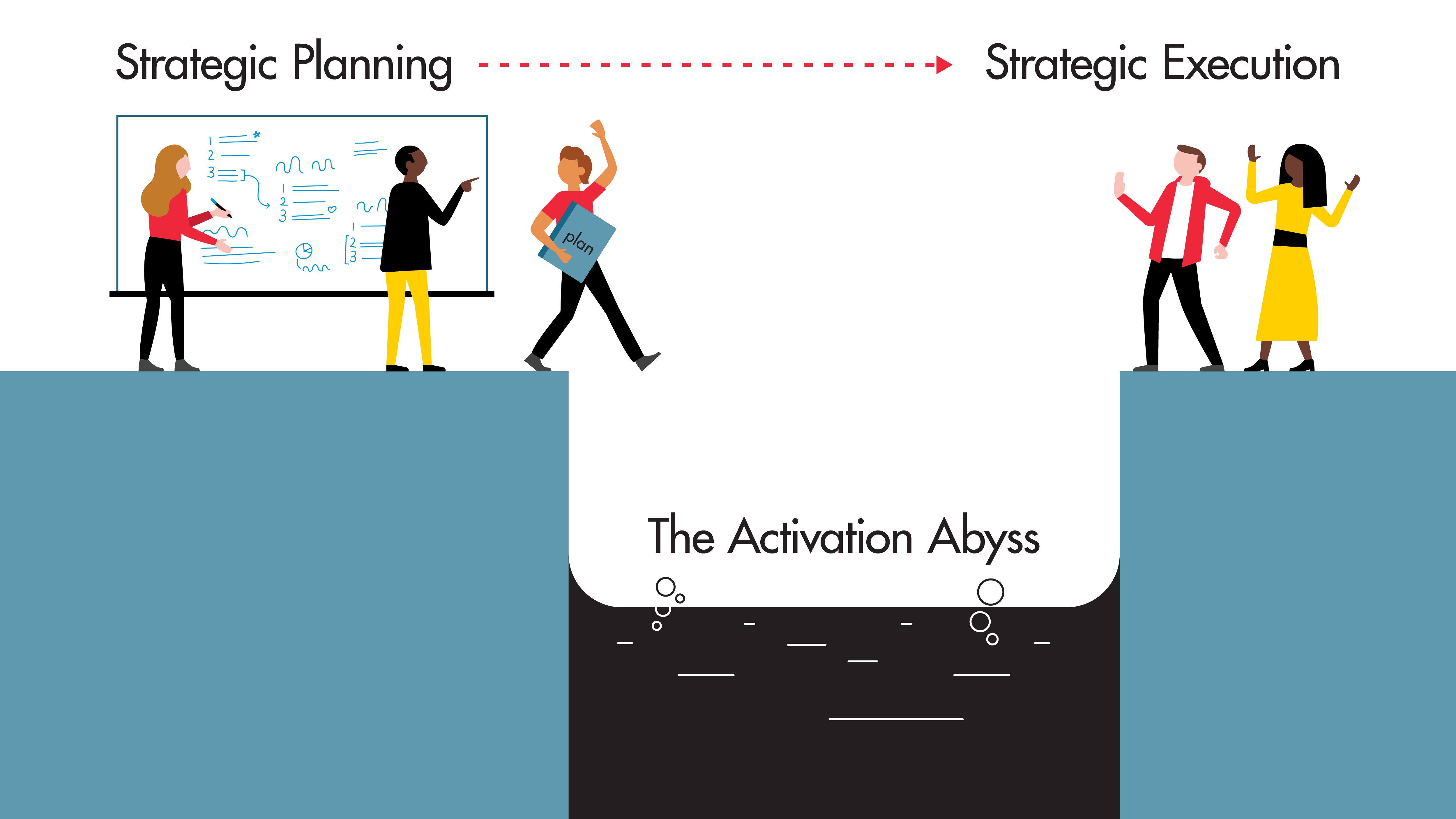Struggling to get your strategy off the ground? Don’t overlook strategy activation! This nuanced step between strategic planning and execution has the power to move organizations forward with finesse.
This blog post is excerpted from The Strategy Activation Playbook: A Practical Approach to Bringing Your Strategies to Life, by Aric Wood, which is now available to order in our store.
The Rise of Strategy Activation
The term strategy activation began to appear in the 2010s, slowly at first and increasing steadily in popularity in the early 2020s. By 2021, Google appearances of the term were double what they were as recently as 2018–2019. We’ve seen a corresponding increase in blog posts, webinars, and even consulting practice areas using the term.
There’s still a lot of confusion between the terms strategy activation, strategy execution, and strategy implementation.
Many ask, “Aren’t they all the same”? Well, no – activation is a step in between. It’s the recognition that prior to implementing or executing anything, people must be persuaded to want to make the change. Strategy activation is what comes between the creation of strategy and the execution of strategy.
Most leaders see these as a continuum: “We’ll design our strategy, and then it’s all about execution!” They try to jump directly from strategic planning to strategy execution. And why not? Don’t we just plan the work, then work the plan? Well, yes and no. As an individual or a small team, this may be the case. But with larger organizations, it’s not so clear.
In a traditional hierarchical organization, this may be the case. Alignment around the case for change is either implicit or required. Engagement is simpler, because the stakeholder needs are seen as homogenous. Movement to action is seemingly frictionless.
But in a more modern, less hierarchical organization, with its greater diversity, empowerment, and independence of thought, the landscape looks different. The path from planning to execution is not a direct line. In fact, an enormous hidden chasm sits between them. If we don’t plan for this—and prepare for how to get our teams across it—we’ll never get to the execution side.
So we need to see this gap as the trap that it is. Between strategic planning and execution is a hidden obstacle where strategy goes to die. What most failed change leaders fail to see is something we call the activation abyss:

This abyss is ever-present and should be clearly visible, but we are so accustomed to the old ways of command and control that we still assume it’s enough just to tell people to cross it.
That doesn’t work anymore because employees now have much more agency to decide for themselves if they’ll follow you. Remember, you recruited them because they were creative, innovative, even entrepreneurial. You empowered them so they could leverage their intelligence and creativity to accomplish work in new and innovative ways. And—this should go without saying—they think for themselves. You hired critical thinkers who don’t just follow orders by design.
Many leaders fail to recognize that between the decision to go to a new place and the actual expedition, a large effort is required to recruit the team, persuade them that your destination is attractive, and support them in preparing for the journey. And it doesn’t stop at persuasion: even if you convince them that they want to join you on the trip, you’ll need to ensure they are prepared with the skills, knowledge, and equipment to be successful.
We can now see the next piece to this puzzle: how do we bridge the gap between planning and execution, and persuade our teams to join us on the journey?
As change leaders, whether personally leading the transformation or supporting the overall effort, our first job is to make this gap clear for all to see. Recognizing this obstacle and making a plan to cross it safely is the single most important factor in becoming one of the strategies that succeed.
The Investment in Activation
We know that the lack of investment in activation is one of the main reasons strategies fail. Avoiding this pitfall means investing energy into closing this gap by persuading people to try new ways of working.
Inertia is powerful: it’s easiest to do something tomorrow the way I did it yesterday. Before someone is willing to try a new way of doing something, they need to be convinced there’s a good reason to do so, and that the new way is better for them than the old way.
To define it clearly, strategy activation is the art and science of persuading people to align around, engage with, and adopt new ways of working in order to achieve a shared vision.
Strategy activation is the art and science of persuading people to align around, engage with, and adopt new ways of working in order to achieve a shared vision.
As such, it is a necessary predecessor to implementing or executing a new strategy. It’s the connective tissue that helps people see why the change is needed, understand what’s required, and be willing to move to action together in a new way.
Only once activation is successful is an organization prepared, equipped, and capable of executing strategy. To implement new ways of working, we need to persuade people to try new things. We need to support them not only with the case for change, but also with the learning, training, and support they need to succeed. This process is like training the body for competition, preparing an orchestra for a new performance, or recruiting people to join a social movement. It takes an investment in activation to overcome inertia and move to a new level.
Why has strategy activation become a thing?
As we transitioned from the industrial age to the information age, and now are entering the purpose age, the center of power in the organization has shifted from the command structure to empowered people. We empowered them to innovate, imagine and create potential futures, question the current state, and think critically about the why of things. The very basis of competition today is creativity and innovation, and this has required us to develop a system of empowered, independent, critical thinkers.
This is a fundamental shift to the organization. We should not be surprised that it has upended traditional command-and-control structures, along with the flavors of change management that developed in parallel to them.
Hence, we’re seeing the rise of a new practice area to accelerate change adoption in organizations: strategy activation. It seeks not to drive change into an organization, but rather to work with its people in a human-centered way: to capture their hearts and minds, develop a shared vision, and persuade them to work together to co-create new futures.
This is a seismic shift, and one every leader should understand deeply. As leaders in this changing world, change is our one constant. The ability to navigate it quickly is the new basis for competitive advantage and a requirement for the successful achievement of organizational purpose.
Additional Tools and Resources
To learn more about strategy activation, we recommend the following tools and resources:
